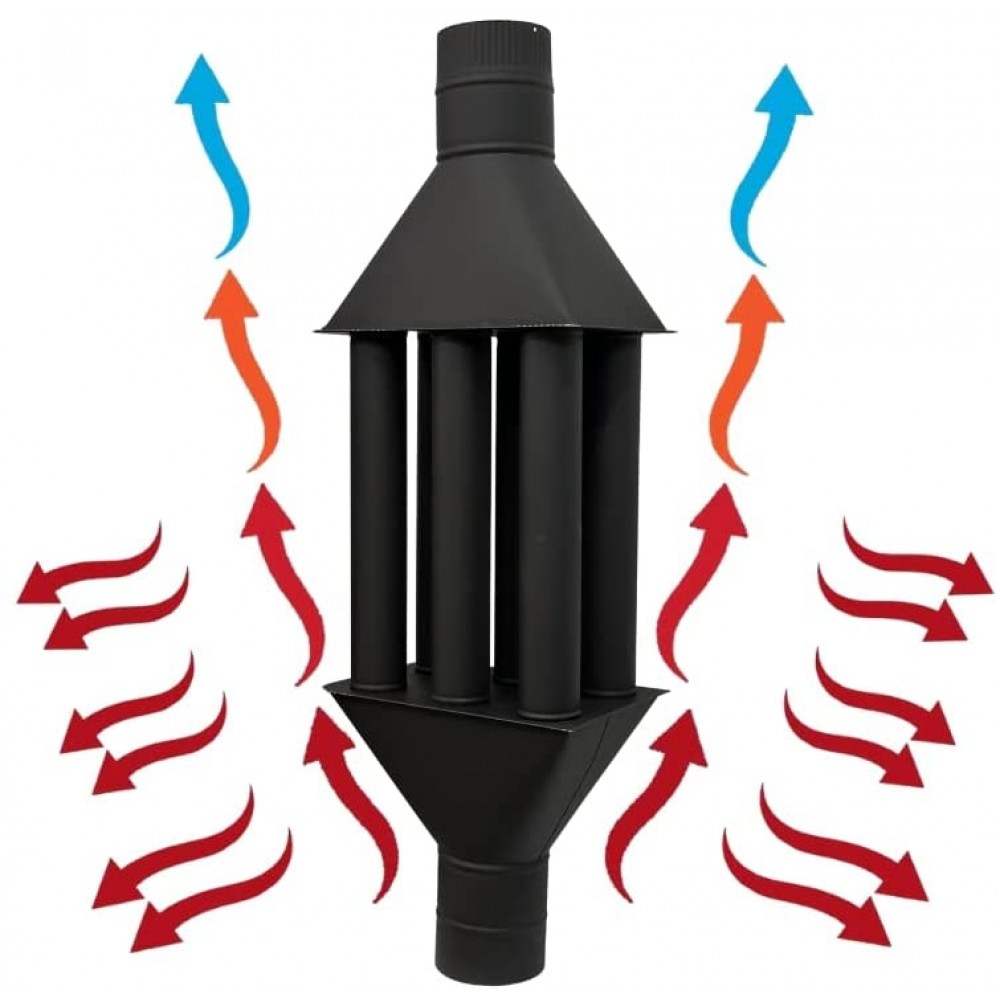Chimney Heat Exchangers
There are no products to list in this category.
Increase the Efficiency of Your Fireplace with Heat Exchangers from BalkanEnergy!
Do you want to get more heat from your wood stove and reduce heating costs? BalkanEnergy offers you high-quality fireplace heat exchangers that significantly increase the efficiency of your heating.
How Do Fireplace Heat Exchangers Work?
Our heat exchangers are placed directly after the wood-burning fireplace and are made of durable black sheet metal. They are designed to extend the path of the flue gases, thereby increasing heat transfer and retaining more heat in the room instead of it escaping through the chimney.
Principle of Operation of the Fireplace Heat Exchanger
- The fireplace heat exchanger operates on the principle of efficient absorption and distribution of the heat generated by the combustion process. When wood or coal burns in the fireplace, flue gases are released, which usually exit through the chimney, losing a large portion of the generated heat.
- The heat exchanger captures these hot gases and directs them through a specially designed system of metal fins or tubes. These elements are designed to increase the contact surface between the heated gases and the heat exchanger itself, allowing a larger amount of heat to be absorbed.
- The absorbed heat is then transferred to the air circulating around the heat exchanger. Depending on the design, this air can be heated naturally (through convection) or by a fan, which speeds up the process and helps distribute the heat faster throughout the room.
- Thus, instead of heat being irretrievably lost through the chimney, it is used as efficiently as possible for home heating. The even distribution of warm air improves comfort in the room, reduces temperature differences, and contributes to lower fuel consumption, making the heating process more environmentally friendly.

What Models Do We Offer?
- Volcano-Type Fireplace Heat Exchanger – With 6 fins for maximum heat transfer, this model is designed to extract as much heat as possible from the flue gases. Thanks to the increased contact surface, it ensures rapid and even heating of even large rooms, reducing fuel consumption and improving overall heating efficiency.
- Standard Fireplace Heat Exchanger – With 5 fins, suitable for smaller rooms, this model is a compact and practical solution for improving heating efficiency. It offers a good balance between cost-effectiveness and performance, is easy to install, and provides a more comfortable heat distribution in the home.

Main Advantages of Fireplace Heat Exchangers
- Increased Efficiency – Heat exchangers increase the amount of usable heat generated by the fireplace by optimizing the energy transfer process. This allows for better fuel utilization and higher room temperatures without additional costs.
- Long Lifespan – Made from high-quality materials resistant to high temperatures and wear, heat exchangers retain their properties even with intensive use. Anti-corrosion coatings and robust construction ensure reliable performance for years.
- Energy Savings – Reduce heating costs by utilizing the available heat more efficiently and directing it to heated areas. This allows for significant reductions in electricity or alternative heating expenses during cold months.
- Eco-Friendliness – Reduce carbon dioxide emissions by allowing more efficient fuel combustion, leading to fewer harmful exhaust gases. Better energy utilization also reduces the need for additional heating resources, contributing to environmental protection.
- Improved Heat Circulation – Distribute heat evenly, reducing temperature differences in the room and creating a more comfortable indoor climate. This eliminates cold spots and ensures a pleasant and consistent temperature throughout the living space.
- Easy Installation – Suitable for most standard fireplaces, with the option for professional installation or DIY setup. Thanks to their universal design, they can be adapted to different types of fireplaces without complex modifications.
Frequently Asked Questions
- How is a fireplace heat exchanger installed?
The installation can be carried out by a professional technician who will ensure that the heat exchanger is properly installed and operates efficiently. - Can the heat exchanger be used with any fireplace?
It is important to ensure that the heat exchanger is compatible with your fireplace and heating system. - How is the heat exchanger maintained?
Regular cleaning and inspections ensure long-lasting and efficient operation. - What should I know before purchasing?
You should consider the power of the fireplace, the type of heating system, and the installation possibilities. - Can the heat exchanger reduce heating costs?
Yes! By using heat more efficiently, you can significantly lower your heating expenses. - Is the heat exchanger compatible with different types of fuel?
Yes, our heat exchangers can be used with both wood and coal. - What is the lifespan of the heat exchanger?
With proper maintenance and regular cleaning, the heat exchanger can operate efficiently for many years. - How long does it take to install the heat exchanger?
Installation usually takes a few hours, depending on the fireplace model and heating system.
Explore our other products:
- Flue pipes and chimneys – for better smoke gas ventilation.
- Chimney Cowls – for protection against atmospheric conditions and improved draft.
Invest in the warmth of your home with BalkanEnergy!

